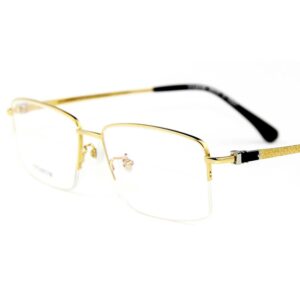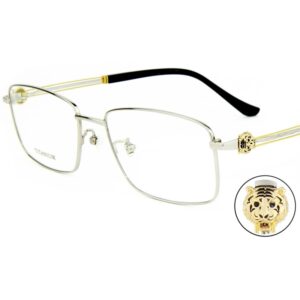Acetate, also known as cellulose acetate, is a type of plastic derived from natural sources like wood pulp and cotton fibers. It stands out for its durability, flexibility, and hypoallergenic properties, making it an excellent material for various applications, particularly in the eyewear industry. Unlike petroleum-based plastics, acetate is more eco-friendly as it is biodegradable. Its ability to be produced in a wide range of vibrant colors and patterns through lamination and layering techniques adds to its appeal, allowing designers to create unique and stylish eyeglass frames.
“Cellulose is the most common organic compound on Earth. About 33% of all plant matter is cellulose.”
Interestingly, different types of fauna contain varying levels of cellulose.
To make sheet acetate, the main source of the cellulose is taken from the white ‘bolls’ of cotton plants or wood pulp as they have very high cellulose purities of as much as 90%.

Cellulose from cotton or wood pulp is taken and refined into purified cellulose.
This extraction is used to make the acetate compound for the manufacture of sheet acetate, used to make spectacles, sunglasses and other items such as hair combs.
To see how this all works, check out the video below to how the compound is processed, dyed and formed by Italy’s oldest and most revered acetate manufacturer; Mazzucchelli.
The use of acetate in eyewear dates back to the early 20th century, revolutionizing the industry by replacing materials like metal and horn, which were less versatile and harder to work with. Over the decades, acetate has become the material of choice for high-quality eyeglass frames due to its superior aesthetic qualities and ease of customization. Its popularity is also attributed to its lightweight nature and comfort, making it ideal for everyday wear. Brands and designers favor acetate for its ability to hold intricate details and its resilience, ensuring that eyeglass frames not only look great but also withstand the test of time.
How is cellulose acetate made?
Is cellulose acetate natural?
Absolutely. It grows.
To make acetate sheets for the production of eyewear, the lifecycle of the cotton begins in vast cotton crops. Usually in the regions of America, Africa and Asia。
Commercial harvesting is carried out via machine which only removes the characterising white ‘bolls’ from the top of the plants, keeping the rest intact.
Once collected, the cotton is then decontaminated from field-debris and insects before being refined into purified cellulose.
1. From the field…

2. To the factory
In a process called organic synthesis, the purified cellulose is mixed with acetic acid.
This formula induces the creation of the compound we know as cellulose acetate.
At this stage, the acetate compound is a neutral, semi-opaque mixture with a very thick viscosity similar to putty or playdough.

3. Adding colour
Using what is called disperse dye, various colours can be introduced to the neutral acetate compound.
For the production of acetate, the disperse dyes are in powdered form which can be pre-mixed to make bespoke colours.
For large batches, the dyes are thoroughly mixed through the acetate by repeatedly rolling the compound through flat metal rollers. This is carried out by skilled workers which you can see in this video.
For small or development batches, the dyes can be manually incorporated by hand. Much like a pastry mix, it’s kneaded, squashed and rolled to achieve a consistent colour throughout the soft compound.
See the images below, courtesy of Mazzucchelli.




4. Block casting
Once thoroughly mixed and rolled, the dyed acetate compound is then placed into large box-shaped moulds.
This is the process known as casting which produces ‘block acetate’ where the compound is cured* as very large blocks before cutting. (Italy’s signature method of acetate production.)
For large batches the acetate is cast inside large 2 metre long block-moulds which are hydraulically squeezed under pressure. This removes any air bubbles and forces patterned acetates with alternating chips/slices to adhere together.
For small batches the process is identical except from the size of the block-moulds. Seen in the images below, manual wheel-presses are uses to exert the necessary pressure to form the acetate blocks.
* Curing: In the production of plastics, curing, is the process of toughening or hardening a polymer where it changes state to become more solidified.


5. Patterns & tones
Once cured, the acetate is ready to be sliced into finished sheets or ‘chipped’ into tiny coloured pellets.
Sounds strange, but the reason for chipping, is that the pellets can be heated and interspersed with other colours of acetate.
By artfully layering differing tones, opacity’s and colours of pre-made acetate, the chips are placed back into the moulds to make a hybrid block of speckled acetate such as imitation tortoise shell.
It’s these extensive and lustrous acetate patterns which have made Italian acetate so desirable within the optics industry.



6. Slicing sheets
Once fully cured, the acetate blocks are placed onto a moving bed which hydraulically pushes the block against an angled cutting knife.
Much like a wood-pane, the knife is set at a pre-determined sheet thickness which shaves layers off the acetate block into sheets of acetate.
Seen in the images below, the freshly cured sheets are still malleable and bendy. Because of this, they tend to curl-up as they’re being cut from the block.


7. Stabilisation
The sheets are manually removed by skilled workers who hang the sheets of freshly cut acetate in what look like coat-rails, ready for heat-stabilisation.
In an oven, the acetate is held at a consistent temperature for several days before storage or dispatch, ready for glass making.


Making acetate glasses frames
Two things you should know.
Sheet acetate for glasses is made in various countries around the world.
Which is nice, considering we can reduce the carbon footprint shipping with a material that can biodegrade
So once every month or so, large sheets of freshly made acetate arrive outside our workshop doors.
Large and bendy, we cut them into more manageable strips using a table saw and two pairs of steady hands.
Our hands.

What are acetate glasses?
Since the 1940’s, cellulose acetate has been marketed using various trade-names.
Depending on the manufacturer and location, it can be referred to as Zylonite, Zylo, Zyl, Cellon, Celluloid, Tenite or Rhodoid.
But regardless of name, the material itself was always made using cellulose, deriving from wood pulp or cotton bolls.
In basic form, there are three main parts of glasses frames.
· An acetate frame-front
· Two acetate sides (otherwise known as temples.)

Frame front
Frame fronts are generally a 6/8mm thick section acetate that is machined using precision CNC milling.
Using various cutting bits, the frame front is sculpted at various angles, speeds and RPM (revolutions per minute.)
Lens holes, lens grooves, hinge graves, hinge holes and nose apertures are all cut from a single piece of acetate to make the front.
After machining, following stages of heating and forming take place to give the frame it’s curvature to accept lenses and for facial comfort.

Temples
Sometimes they’re called legs or arms.
You can see why… but the proper name is temples.
Similar to the frame front, they’re CNC machined or die-cut from a thinner 4/6mm thick acetate.
To maintain their shape and curvature, acetate temples are usually reinforced by a metal ‘core’. This is achieved by heating the temple and quickly forcing a pointed core into the heated acetate temple.
The process is known as wire shooting.
The cores can often be commonly seen within the temple, especially if the acetate is transparent providing nice detail, quality and longevity.

What are the benefits of acetate for glasses?
Sheet acetate has a number of benefits which makes it perfect for spectacle making.
As mentioned previously, acetate is a bio plastic which supersedes synthetic alternatives due to the fact it can biodegrade.
Other major benefits include…
o Hypoallergenic | which means it won’t react with your skin. [?]
o Lightweight | making it easy to wear for long periods of time without sliding down your nose or becoming cumbersome or uncomfortable.
o Vast colour options | due to the way it can be dyed during the manufacture process. This yields endless colour and pattern options to suit many different styles and skin tones.
o Can be transparent | which other materials cannot achieve.
o Made from natural fibres | Whilst cotton grows, it absorbs C02 emissions and creates jobs via cultivation, harvesting and processing. Synthetic fibres and compounds use more energy to produce and have a higher carbon footprint in their production.
o Adjustable | With experience, opticians and frame makers like us have the ability to heat and manually adjust acetate glasses frames. In turn, they’re more comfortable for you to wear.
How long does it take for cellulose acetate to decompose?
Tests were carried out in 1997 via ResearchGate, where a cellulose acetate cup was left in waste sewage for a period of 18 months.
During which time, the cup lost 70% of it’s original weight.
Whilst it didn’t fully disappear within the 18-month period, a 70% mass reduction is a promising rate of degradation.
The environmental impact of cellulose sourcing is a significant consideration in acetate production.
Sustainable forestry practices and the use of certified wood sources help minimize deforestation and habitat destruction, ensuring a more eco-friendly supply chain.
Similarly, cotton linters, being a byproduct of the cotton industry, contribute to waste reduction by utilizing material that would otherwise be discarded.
Additionally, cellulose acetate is biodegradable, offering a greener alternative to traditional petroleum-based plastics. However, the chemical processes involved in converting cellulose to acetate require careful management to minimize environmental harm, making it crucial for manufacturers to adopt sustainable practices and invest in cleaner technologies.
Comparing Acetate with Other Materials
Acetate vs. Plastic: Pros and Cons
Acetate Pros:
· Eco-Friendliness: Acetate is made from renewable plant fibers, making it biodegradable and more environmentally friendly compared to petroleum-based plastics.
· Durability and Flexibility: Acetate frames are known for their durability and flexibility, providing a comfortable fit that can be easily adjusted without breaking.
· Aesthetic Variety: The manufacturing process allows for a wide range of colors, patterns, and textures, enabling unique and stylish designs.
Acetate Cons:
· Cost: Acetate frames tend to be more expensive than plastic frames due to the higher cost of raw materials and the more complex manufacturing process.
· Weight: While generally lightweight, acetate can be heavier than some modern plastic materials, which may affect comfort for some wearers.
Plastic Pros:
· Cost-Effective: Plastic frames are typically cheaper to produce, making them more affordable for consumers.
· Lightweight: Many plastic frames are extremely lightweight, enhancing comfort for prolonged wear.
· Versatility: Plastic can be molded into virtually any shape and style, offering a wide range of design possibilities.
Plastic Cons:
· Environmental Impact: Traditional plastic frames are derived from petroleum and are not biodegradable, contributing to environmental pollution.
· Durability: Plastic frames can be less durable and more prone to breakage compared to acetate frames.
Acetate vs. Metal Frames: A Comparative Analysis
Acetate Frames:
· Comfort: Acetate frames are generally more comfortable due to their flexibility and ability to conform to the wearer’s face.
· Aesthetics: The variety of colors and patterns available with acetate makes it a popular choice for fashion-forward designs.
· Hypoallergenic: Acetate is hypoallergenic, reducing the risk of allergic reactions for sensitive individuals.
Metal Frames:
· Strength: Metal frames are typically stronger and more resistant to impact than acetate frames.
· Weight: Modern metal frames, such as those made from titanium, can be extremely lightweight, providing a comfortable fit.
· Durability: Metal frames are highly durable and less likely to warp or break compared to acetate frames.
· Adjustability: Metal frames can be easily adjusted for a more precise fit, although they can lose shape over time if not handled carefully.
Cons of Metal Frames:
· Allergies: Some metals, especially nickel, can cause allergic reactions in certain individuals.
· Limited Color Options: While metal frames can be coated or painted, they generally offer fewer color and pattern options compared to acetate.
Acetate vs. Wood: Aesthetic and Functional Differences
Acetate Frames:
· Aesthetic Versatility: Acetate frames can be produced in a wide array of colors and patterns, offering more design flexibility.
· Comfort and Fit: Acetate frames are lightweight and flexible, providing a comfortable and adjustable fit.
· Durability: Acetate is durable and resistant to everyday wear and tear, making it a long-lasting material for eyeglass frames.
Wood Frames:
· Natural Look: Wood frames offer a unique, natural aesthetic that appeals to eco-conscious consumers and those seeking a distinctive look.
· Sustainability: Many wood frames are made from sustainably sourced materials, making them an environmentally friendly option.
· Lightweight: Despite their solid appearance, wood frames can be surprisingly lightweight and comfortable.
Cons of Wood Frames:
· Fragility: Wood frames can be more fragile than acetate and are more susceptible to damage from moisture and impact.
· Limited Adjustability: Unlike acetate, wood frames cannot be easily adjusted for fit, making precise sizing crucial.
· Color Options: While wood frames can be stained or painted, the color options are generally more limited compared to the vibrant and diverse patterns available with acetate.
Each material offers distinct advantages and disadvantages. Acetate provides a balance of durability, aesthetic flexibility, and comfort, making it a popular choice for many eyeglass wearers.
Plastic offers cost-effectiveness and lightweight comfort but lacks environmental sustainability.
Metal frames offer strength and adjustability but have limited design options and potential allergy concerns. Wood frames offer a unique, eco-friendly aesthetic but are less durable and adjustable than acetate.
Conclusion
The journey of acetate from natural cellulose to stylish eyeglass frames is a fascinating blend of science, craftsmanship, and innovation. The meticulous manufacturing process, which includes extracting and purifying cellulose, undergoing acetylation, and then carefully coloring and shaping the acetate sheets, highlights the complexity and precision involved in creating high-quality eyewear. This detailed process not only ensures the durability and flexibility of acetate frames but also allows for an impressive range of colors and patterns, making them a popular choice for both designers and consumers.
Understanding the art of acetate manufacturing gives us an appreciation for the craftsmanship and technology that go into every pair of acetate eyeglass frames. These frames stand out not only for their aesthetic appeal but also for their environmental benefits, durability, and comfort. As the eyewear industry continues to innovate and prioritize sustainability, acetate remains a key material that combines natural origins with modern design possibilities, offering endless creative potential for unique and stylish eyewear.
Part Acetate Sheet Colors Reference for OEM Acetate Eyewear
Monocolor

Multilayers

Gradient

Demi Gradient

Demi

Stripe

Classical Havana

Colored Havana

Dry Block

Havana Lamination

Print Lamination

Lamination


























